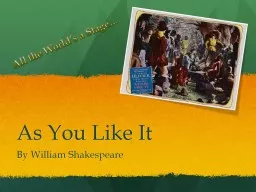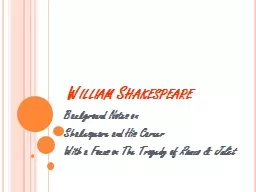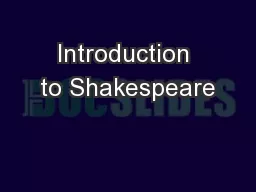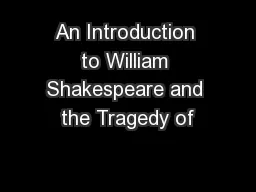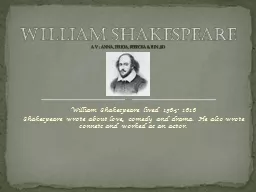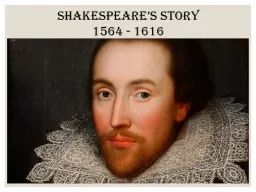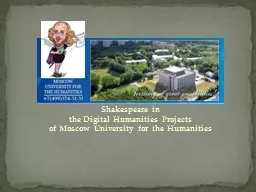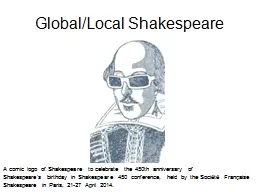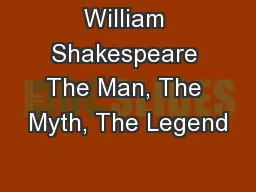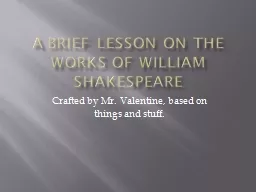PPT-As You Like It By William Shakespeare
Author : sherrill-nordquist | Published Date : 2018-03-11
All the Worlds a Stage Background SourcesWhen Written N ovel Rosalyne or Euphues Golden Legacy Published 1590 by Thomas Lodge Lodges novel based on The Tale
Presentation Embed Code
Download Presentation
Download Presentation The PPT/PDF document "As You Like It By William Shakespeare" is the property of its rightful owner. Permission is granted to download and print the materials on this website for personal, non-commercial use only, and to display it on your personal computer provided you do not modify the materials and that you retain all copyright notices contained in the materials. By downloading content from our website, you accept the terms of this agreement.
As You Like It By William Shakespeare: Transcript
All the Worlds a Stage Background SourcesWhen Written N ovel Rosalyne or Euphues Golden Legacy Published 1590 by Thomas Lodge Lodges novel based on The Tale of Gamelyn. Study Guide Review. 1. What did Shakespeare consider his main profession to be? (Bloom: Knowledge). He considered himself to be more of an actor than a writer.. 2. Explain why Shakespeare might find it unusual for people to study his plays . Background Notes on . Shakespeare and His Career. With a Focus on The Tragedy of . Romeo & Juliet. A Shakespearean Joke. While visiting his Grandma in Texas, Billy spotted a bowlegged cowboy. “Look at . Greetings from me, The Bard, England’s greatest poet and storyteller. You thought I was just the greatest writer? I am also the rudest man in England!. LEARNING OBJECTIVES. By the end of this lesson: . Romeo & Juliet. Ms. Forsyth and Mr. Bernstein. Honors English 9. Bear Creek High School. This presentation will…. inform you about the life and work of the mysterious William Shakespeare.. provide you details about Elizabethan society and theater.. 1564-1616. The “be-all and end-all” of dramatists. CLICK ON SPEAKER TO HEAR SOUND. CHILDHOOD. Born in . Stratford-upon-Avon. Son of a glove-maker. Grammar school education. (6am-6pm) boys studied Latin:Cicero,Virgil,Ovid, and Seneca. lived. 1564- 1616. Shakespeare . wrote. . about. love, . comedy. and drama. . He. . also. . wrote. . sonnets. and . worked. as an . actor. . . William Shakespeare. Av: Anna, Felicia, Rebecka & Elin, 8D. story. 1564 - 1616. Who was Shakespeare?. William Shakespeare was a poet, actor and playwright.. One of the world’s greatest playwrights of all time.. Writing in England during the late 1500’s and early 1600’s during the reigns of Queen Elizabeth I and King James I. . Queen Elizabeth I - born September 7, 1533 in . Greenwich. Died March 24, 1603 in Richmond, Surrey. Daughter of King Henry VIII and Anne Boleyn . (. beheaded by Henry for not bearing a son). Coronated. the Digital Humanities Projects. of Moscow University for the Humanities. RESEARCH DATABASE “RUSSIAN SHAKESPEARE”. www.rus-shake.ru. Russian translations. Criticism. Shakespeare in original oeuvre. Henry IV, Part 1. William Shakespeare: Poet, Playwright, Social Deviant, Gentleman. . Baptized in Holy Trinity Church in Stratford-upon-Avon (Warwickshire, England) on April 26, 1564.. No record of his actual birthday was recorded, but it is widely accepted that he was born within a week of his baptism.. A comic logo of Shakespeare to celebrate the 450th anniversary of . Shakespeare's birthday in Shakespeare 450 conference, held by the Société Française . Shakespeare in Paris, 21-27 April 2014.. Shakespeare in Global/Local Contexts. Why do we study Shakespeare?. He is an amazing wordsmith. Many of the words and phrases we use today were coined by Shakespeare.. Look familiar?. barefaced . fancy-free. catch a . cold. . disgraceful conduct . What do you know about William Shakespeare?. Shakespeare was . born in . Stratford. -upon-. Avon. , England, in . April . 1564 . and . died on 23rd April 1616. We know that he was . baptised. on 26th April 1564 and scholars now believe that he was born on April 23rd. He therefore died on his fifty-second . A Brief Lesson on the Works of William Shakespeare Crafted by Mr. Valentine, based on things and stuff. Step 1 – The Bio The textbook offers a brief biography of William Shakespeare. Let’s read it together before moving on.
Download Document
Here is the link to download the presentation.
"As You Like It By William Shakespeare"The content belongs to its owner. You may download and print it for personal use, without modification, and keep all copyright notices. By downloading, you agree to these terms.
Related Documents

